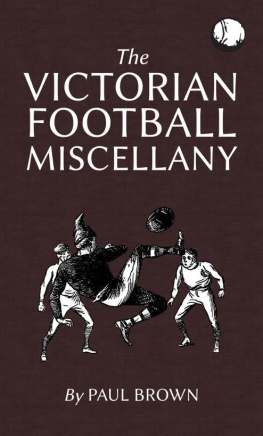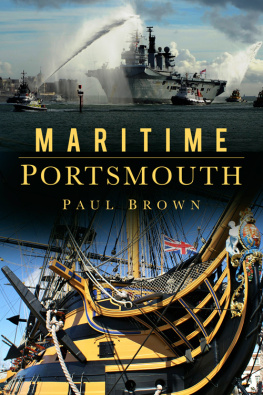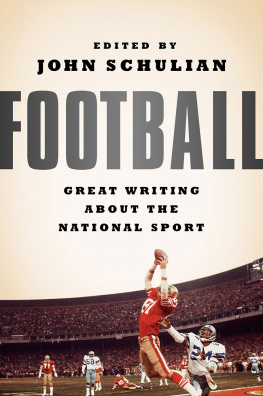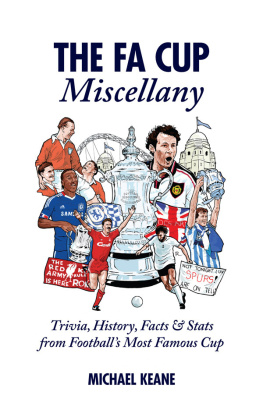THE VICTORIANFOOTBALL MISCELLANY
PAUL BROWN
SmashwordsEdition
Copyright Paul Brown 2013
Paul Brown hasasserted his right under the Copyright, Designs and Patents Act1988 to be identified as the author of this work.
A CIP datarecord for this book is available from the British Library.
This ebook islicensed for personal use only. It may not be reproduced, re-soldor given away. Thank you for respecting the work of the author andothers involved in producing the ebook.
Every efforthas been made to identify image rights holders and obtainpermissions where relevant. The publisher will be pleased torectify any omissions at the earliest opportunity.
Cover imagesfrom Sketches at the International Football Match by WilliamRalston, the Graphic, 1872.
For moreinformation and content go to:
www.victorianfootball.co.uk
www.superelastic.co.uk
AUTHORS NOTESAND ACKNOWLEDGMENTS
Although bydefinition miscellaneous, it is intended that the various items inthis Miscellany will add up to provide an overall history ofVictorian football. In an effort to provide some logical structure,the items in the book have generally been arranged in chronologicalorder. For the purpose of the book, Victorian era refers to theperiod from Queen Victorias ascension in June 1837 until her deathin January 1901.
Sources forthis book included hundreds of contemporary newspaper andperiodical articles far too numerous to fully reference, althoughefforts have been made to name sources as they are used. Usefulbooks and websites are referenced in the Further Reading section.Thanks to library and archive staff for their assistance, and toJonathan Hayden for his help.
Special thanksto Louise for tolerating my football obsession, particularly whenmy team loses.
www.stuffbypaulbrown.com
www.twitter.com/paulbrownUK
ALSOAVAILABLE
Goal-Post:Victorian Football vols 1 & 2
Edited by PaulBrown, available as paperback and eBook
A new anthologyseries collecting the very best Victorian football writing,covering the birth and development of the worlds greatest game,written by those who were there to witness it. This is a collectionof contemporary articles and extracts featuring some of theplayers, officials, clubs and matches that helped shape and definefootball.
www.victorianfootball.co.uk
PRE-VICTORIANFOOTBALL TIMELINE
c.350BC: The Ancient Greeks play a game called episkyros, aviolent form of football that allows handling. Documented inwritings and artwork, it is also referred to as battle ball.
c.250BC: A kicking game, known as tsu chu or cuju(kickball), is played in Han Dynasty China. It involves kicking afur-stuffed ball through a small hole in a silk cloth.
c.100BC: The Ancient Romans play several ball games, includingfollis, or balloon-ball, and harpastum, a kickinggame derived from the Greek episkyros. Some historiansbelieve the Romans brought harpastum to Britain c.50 AD.
828 AD:The important Anglo-Saxon text Historia Brittonum includesthe first reference to football in Britain, mentioning a party ofboys playing at ball.
c.1180:Canterbury monk William FitzStephen writes that boys annually uponShrove Tuesday go into the fields and play the well-known game ofball.
1314:The Mayor of London bans hustling over large foot balls in publicareas of the city on pain of imprisonment.
c. 1389:Richard II outlaws all playing at tennis, football and othergames in the belief that they encourage idleness.
1409:Henry IV bans the levying of money on foetball.
c. 1500:Italians play a complicated kicking game called calcio.
1526:Henry VIII orders a pair of football boots.
c.1595 and1605: William Shakespeare references football in both AComedy of Errors and King Lear. (From Lear: Steward:Ill not be strucken, my lord. Kent: Nor tripped neither, youbase football player.)
1755: DrSamuel Johnsons Dictionary of the English Language containsthe entry: FOOTBALL: A ball commonly made of a blown bladder. Thesport or practice of kicking a football.
1801:Historian Joseph Strutt writes a description of the game, beginningwith: Football is so called because the ball is driven about withthe feet instead of the hands.
c. 1815:Poet Walter Scott writes two songs about a football match inScotland: ...And life itself is but a game at football.
THE MOB GAME
Football was acommon pastime at the beginning of the Victorian era. Indeed,reports of the festivities surrounding the coronation of QueenVictoria in 1837 mention several celebratory football matches. Thegame, however, was very different to the football we know today.The most prevalent organised form of football was the folk ormob game, played in towns and villages across the country.Matches would often be played on holidays and other specialoccasions. Several towns arranged games on Shrove Tuesday, whichwas traditionally a half-day holiday. As a result, the mob game issometimes referred to as Shrovetide football. Games could involvehundreds of players, with a villages men-folk divided into twoteams according to various attributes such as height, age ormarital status. Inter-village matches were also common, adding adash of local rivalry to the mix. Rules differed by region, buttypically goals (or gates) would be set up a fair distance apart,often at each end of the village. The ball would be thrown up tostart the match, and each team would attempt to drive it throughtheir opponents goal. The first team to score a goal would win thegame. This could last all day, and would often take its toll on theplayers (and the village). It was a hectic and violent game, withtripping and kicking at shins allowed, and there were many brokenlegs and other injuries. Fatalities werent uncommon, and there arenumerous reports of matches turning into riots. There is an accountof a French visitor who, on observing a village game, remarked thatif the English called this playing, it would be impossible to saywhat they would call fighting. He was referring to a Shrovetidematch that is still played annually at Ashbourne, Derbyshire,between the upards and downards. The village footballtradition also endures in Alnwick, Northumberland. This Shrovetidematch was originally played between the married men and the singlemen of the town, with a cash prize provided for the winners by theDuke of Northumberland.
PUNISHABLEOFFENCE
Before footballwas codified, and before pitches were marked out, the game wasplayed in the streets. As a result, it was not uncommon to seemasses of men and boys charging through towns and villages up anddown the country, causing much bedlam and disorder, in pursuit of afootball. Normal life was disrupted, windows were broken, andcitizens were trampled. There were regular arrests and trialsinvolving football-related disturbances and breaches of the peace,ranging from noise and obstruction to destruction of privateproperty, with plenty of violence thrown in, too. The Highway Actof 1835 had actually outlawed the playing of football on publichighways, with a maximum penalty of 40 shillings. (Playingfootball on a highway to the annoyance of a user is stillprohibited today.) In 1848, the Sportsmans Gazette published thisadvice: The game of football is not illegal if played in a fit andproper place, but of course if it is practised in publicthoroughfares, creating a disturbance and obstruction, it thenbecomes a punishable offence. This crackdown on street games wasinstrumental in football becoming a field game.
EARLY RISERS
One of thefirst recorded clubs formed with the intention of playing footballwas the Early Risers, which is known to have existed in Newcastleupon Tyne in 1848. The clubs remit actually went beyond football and beyond sport. The Early Risers met on the town moor at sixoclock every morning, and would play football, cricket and quoits,and also listen to lectures from guest speakers. Afterwards,members would repair to breakfast with an appetite of 40ploughman-power. Other early Victorian clubs that are known tohave played football in the 1840s included the Great LeicestershireCricket and Football Club, Surrey Football Club, and Rochdales theBody-Guard Club.
Next page













